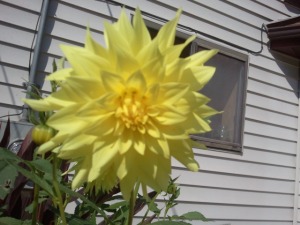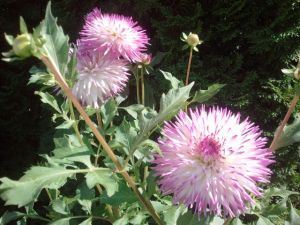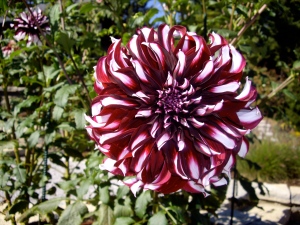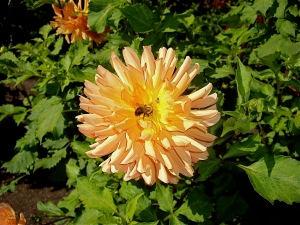After the hot days of summer, the dahlias are in their full glory. I did not know the height or color or even the cultivar of most of them when they were planted. They all grew. Some were very huge. The smallest was about 2.5 feet and the tallest (before the wind got at it) was about 6 feet. Here are some very nice flowers to enjoy on todays’ photoblog. These were taken with a Samsung Fascinate phone, so they are slightly overexposed. Enjoy.
Dahlia Overwintering
May 9, 2010 at 9:13 PM (dahlias)
Last year in September, I inspected my dahlias and decided it was worth a shot at digging up the tubers and storing them. Dahlias are not hardy tubers so they cannot take freezing. In my part of the country, the soil freezes down at least a foot, so if I leave the tubers in place, they will freeze and die. The thing to do is to lift them up, clean them off and store them.
The lifting went extremely well. They are shallowly rooted and at that time, a strong stem was growing out of them. You can wait until the tops have been frozen off by frosts but I just pulled them out a bit early. I trimmed the tops of into a recycling bag, and cleaned up the tuberous root mass. The roots look like either a single sweet potato, or if growing well, a starfish shape of lots of sweet potatoes joined at a big stem. Where the tubers join the central stem part is where the new buds will grow. I tried not to break up the starfish too much. If a tuber breaks off without the shoulder going into the stem part, it will not grow any eyes (buds) next spring.
I spread out the tubers on newspaper in the garage and waited a few weeks until all the soil was dry and dusted off. Then I filled two experimental containers with peat moss.
The main container was a plastic fliptop tote. I started with a layer of 3 inches of dry peat moss in the bottom. Then I tried to lay out the tubers in a single layer without letting them touch each other. I filled in the spaces with peat moss and repeated layer upon layer until the box was full. This box was stored in a closet in an unheated garage next to a heated wall of the house. I was going for a cold but not freezing location. I placed a max/min thermometer on top of the box. Over the course of the winter it was fairly stable and cool, but it dig reach a low of 26 degrees and a high of 62 degrees. Only about 30% of the tubers survived the freezing temperature. I got 11 tubers suitable for planting this spring out of 36.
My other small container only held 2 tubers but they did the best. I put peat moss in a gallon sized ziplock and tossed in the tubers. I squeezed the air out and stored it all winter in the vegetable drawer of the refrigerator. They came out perfect because they did not freeze. The only problem was room to store all the tubers I want to store. Two tubers took up the whole vegetable drawer of the refrigerator, so that is not practical except for a few special ones.
Unearthing the tubers in the spring was kind of a mess with peat moss going all over and rotten tubers being pulled out. I am not sure if all 11 planted tubers are going to be successful. Some of them had a few arms that were questionable. I probably should have trimmed them off but if they die, they die. They are planted in cool soil now but we are getting some warm weather in the next two weeks. It is May 9th here and our 90% frost free date in this part of the country is May 15th. I doubt the tubers will grow any shoots out of the ground to get frozen in the next couple weeks. Here are some photos of the tubers as they came out of the plastic tote.
I guess I will be visiting the dahlia society sales to augment my collection this spring.
Dahlias
December 29, 2009 at 6:19 PM (dahlias)
Tags: dahlias
We have been having fun growing dahlias for a couple years now. I have seen other people grow them over the years. At one time Detroit had a dahlia society and they would plant a nice display garden at the zoo. I have also seen them used 50 years ago as big tall plants in the back of the flower garden producing dinner plate sized blooms. Over the past decades they have been developed as a specialty bedding plant grown from seeds in garden flats and growing into dwarf plants no more than 12 inches tall. They have been bred to cover the color spectrum from white to maroon, yellow, orange, pink and bicolored. The petal shapes vary also from pointed to twisted, curved and uniform to daisy centered. Leaf colors are mostly green but there are purple foliaged types. There are named varieties that are in just about every size and description except blue.
Growing dahlias is very easy. They are botanically a perennial, meaning they will grow from year to year without going to seed and starting over. However they are sensitive to cold weather and cannot withstand freezing. For that reason, they are grown as annual flowers in most temperate gardens. They can be grown easily from seed, but seed from them is not usually available unless you save it yourself. More commonly, the tuberous roots are sold or you may buy them in flats along with annual flowers.
When you buy the tubers in the spring you should look for a living bud or sprout at the neck of the tuber before the old stem base. If the tuber was stored correctly, it should feel like a potato or a little dryer, but not spongy or decayed. If you get one and it does have some damage, you can trim off the bad part and air dry the cut end for about a week until it skins over. They usually will grow out of minor damage if you plant them in warm soil in the sun. Do not try to plant these plants too early in the spring. They are a warm weather grower and in cool soil they will just sit there and may rot. You can start them in the house in flats but I do not think you really gain any blooming time by doing that. They grow and they bloom when the weather is hot and they get lots of sun.
When you plant them outside, just plant them shallowly under a few inches of soil laying the tuber lengthwise in the hole. The plant will develop from the eye or sprout. As the plant gets bigger, the plant will grow new tubers in a starfish pattern all around the crown. The tubers are carbohydrate sinks, so in order to get lots of tubers, they need to grow vigorously and have lots of leaf surface to make sugars they want to store for the winter.
The dahlia is the national flower of Mexico. It can be found in many works of art and flags and family symbols. It is a hot-weather grower. By that I mean that its metabolism is not very active until the temperature reaches 60-70 degrees. Colder temperatures can be endured, but the plant will sit there and not grow or change until it is warmer. The sugars it creates are stored as a form of starchy fiber called inulin. This is edible but has a very high, indigestible fiber content. They are non poisonous and people can eat them, but they are not that good to eat.
As the plants grow larger, they can be staked or not. If you do not stake them, they fall over and grow in a curve up from the ground into a candelabra shaped plant. The wind can crack off the plants if they are staked too low and the ties create a fulcrum point that pinches the stem and cracks it. The peony cages are a good idea for supporting the plant but not pinching the stem at a single point. I have had success with them by not staking them at all.
If you are growing single blooms that you want for a plant show or something, pinch off the buds as they form in the axil of the leaves. Just leave one flower bud per stem and supposedly, the remaining bud grows to a larger flower size. Actually, I think the flower may grow about 10-20 percent larger on a single flowered stem, but you get more nice flowers if you let them grow without thinning.
At the end of the summer, the plants will die off from a hard frost. If you leave them in the ground for a week or two after the tops die, the buds at the base will think it is time for them to begin to grow. You want them to get the idea that the next thing to do is to grow from that basal bud but do not let them actually begin to sprout. Pull them up, trim off the stems, and shake off the soil. Allow them to dry thoroughly on newspapers or somewhere where they will really dry out and not mildew. Shake off the rest of the soil, and box them up in a flip top tote covered with peat moss or vermiculite. Any cuts or breaks on the tubers will skin over and dry like a potato. They will stay dormant like that if they can be kept above freezing but as cold as 40 degrees. If they are too warm, they may try to start growing.
The pests and diseases that dahlias get seem to be minimal. I have had some lepidopterous caterpillars get into the flower petals and eat, but that has been the extent of it so far.
If you want to grow dahlias, you can get certain colors or forms by contacting a dahlia club in your area. It seems to be a flower with many fanciers who get into growing them for a hobby.
http://www.dahliahill.org/ See these guys for a very cool Dahlia Garden locale in Midland, Michigan



















